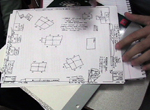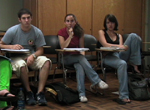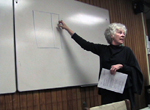MAPPING
To introduce classroom observation, I have students draw a map of their placement classroom, labeling major areas and describing how they are used. Besides helping students get to know their classroom and how it works, map making lets my students practice making connections between the surface structure and the deep structure of the classroom.
As students describe different environmental choices which their teachers have made, we discover that although many classrooms have libraries, the rules for using them differ. We also discover that different classroom setups reflect different “views of knowledge”
WATCHING A 3rd GRADE MATH LESSON
Watching a tape of Deborah Ball teaching a math lesson to third graders opens up a rich discussion about the teacher’s role. Before turning to the videotape, we have been discussing an essay by Vivian Paley, “On Listening to What the Children Say” (Harvard Education Review,56(2), 122-131) which emphasizes the need for teachers to be genuinely curious about what students think. Ball clearly models a view of teaching based on listening to and building on students’ mathematical ideas. Her practice challenges some students’ expectations about the teaching and learning of mathematics. For example, Anna says “If she is the math teacher, she has to explain it so the children have the correct answer.” I end by asking students to think about where their ideas about what the teacher should do come from. We have included most of the discussion because it provides a useful window on the thinking of these beginning teacher education students.
TAKING FIELD NOTES
I introduce a format for taking field notes in which descriptive statements are separated from interpretive and evaluative statements and we practice the strategy while observing a videotape of a 3rd grade math lesson. I ask students to try taking this kind of notetaking on their next visit to the field. Reviewing the results, I notice that students are not providing enough descriptive details or recording their questions and reactions. So I make copies of one student’s fieldnotes for us to analyze together.
I create another opportunity to practice observing and taking notes using the website of Mattie Davis, a 1st grade teacher in Philadelphia. This activity serves two additional purposes: (a) it allows me to introduce the Carnegie cases and prepare students to investigate Gillian Maimon’s site; and (b) it gives students an example of how a teacher “breaks out of the routines” as she takes her children on a walk around the school in order to inspire their writing.






